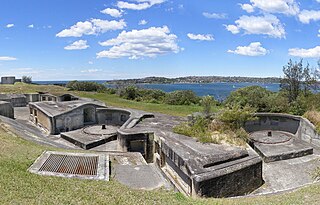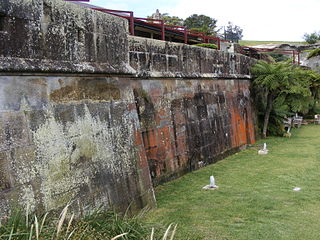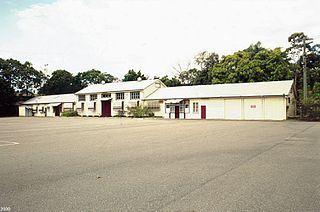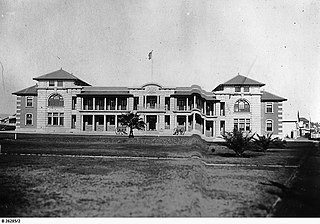Enoggera Barracks is an Australian Army base in the northwestern Brisbane suburb of Enoggera in Queensland. It was officially established in the early 20th century when the area was used for field training, although the area was used by military units as far back as the mid-19th century. Since then it has been developed into a modern military base, which is now home to units of the 7th and 11th Brigades as well as the headquarters of the 1st Division and the 16th Aviation Brigade.

Enoggera is a suburb in the City of Brisbane, Queensland, Australia. In the 2016 census, Enoggera had a population of 5,157 people.

The Middle Head Fortifications is a heritage-listed former defence establishment and military fortifications and now public space located at Middle Head Road, Middle Head, Mosman in the Mosman Council local government area of New South Wales, Australia. It is also known as the Middle Head Military Fortifications or The Old Fort. The fortifications consist of the Outer Middle Head Battery located at the end of Old Fort Road, the Inner Middle Head Battery located at the end of Governors Road, and the Obelisk batteries reached by a path from the corner of Middle Head Road and Chowder Bay Road. The fortifications at Middle Head formed part of Sydney Harbour's defences. The property is owned by the NSW Office of Environment and Heritage. It was added to the New South Wales State Heritage Register on 2 April 1999.

The Georges Head Battery, also called the Georges Head Military Fortifications, is a heritage-listed former military fortification located on the Georges Head on Chowder Bay Road, Georges Heights, in the suburb of Mosman, in the Mosman Council local government area of New South Wales, Australia.
Victoria Barracks is an Australian Army base in the Brisbane suburb of Petrie Terrace in Queensland.
Thomas Pye was an Australian architect. He worked for over 33 years in the Public Works Department in Queensland. Pye contributed significantly to major buildings including the completion of the Public Offices and Rockhampton Customs House, as well as the design for the Lands and Survey Offices. He was responsible for the heightened expectations which produced the best public buildings yet seen in Queensland.

Irwin Barracks is an Australian Army military base located in Karrakatta, a suburb of Perth, Western Australia. It occupies a 62-hectare (150-acre) site on the western side of the Fremantle railway line.
The 11th Engineer Regiment(11ER) is an Australian Army Reserve engineer regiment trained for sapper/combat engineer and construction engineer operations. While 11 ER was formed on 1 January 2014 as a result of recent Australian Army modernisation efforts, 11 ER's lineage is traced back to early Queensland volunteer engineer units as early as 1879. In 1916, 11th Field Company was formed and during World War I, this unit was renowned for action during the Battle of the Somme and the Hindenburg Line. During World War II, it fought the Japanese during the Kokoda Track campaign and on Bougainville Island. The Regiment's Headquarters is located at Gallipoli Barracks in Brisbane, Queensland with subunits located across Queensland. 11ER is part of 11th Brigade, attached to Forces Command.

Commonwealth Acetate of Lime Factory is a heritage-listed factory at 82 Colmslie Road, Morningside, City of Brisbane, Queensland, Australia. It is also known as Colmslie Migrant Hostel, Fairmile Naval Base, Hans Continental Smallgoods Factory, and HMAS Moreton, Colmslie. It was added to the Queensland Heritage Register on 7 December 2007.

Gona Barracks is a heritage-listed barracks at 3, 7,12, 25 & 26 Gona Parade, Kelvin Grove, City of Brisbane, Queensland, Australia. It was built from c. 1914 to 1960s. It is also known as Kelvin Grove Military Reserve and Kelvin Grove Training Area. It was added to the Queensland Heritage Register on 7 February 2005.

Training Depot Drill Hall Complex is a heritage-listed former drill hall at Archer Street, Rockhampton City, Rockhampton, Rockhampton Region, Queensland, Australia. The complex was added to the Queensland Heritage Register on 5 June 2007.

Kissing Point Fortification is a heritage-listed fortification at 38-40 Howitt Street, North Ward, City of Townsville, Queensland, Australia. It was designed by Peter Scratchley and Major Edward Druitt and built from 1891 by A McMillan and then from 1939 to 1941. It is also known as Jezzine Barracks. It was added to the Queensland Heritage Register on 5 February 2010.

Stanthorpe Post Office is a heritage-listed post office at 14 Maryland Street, Stanthorpe, Southern Downs Region, Queensland, Australia. It was designed by John Smith Murdoch of the Queensland Government Architect's office and was built by D. Stewart and Co in 1901. It was added to the Australian Commonwealth Heritage List on 22 June 2004.
Defence Explosive Factory Maribyrnong is a heritage-listed military installation and former munitions factory at Cordite Avenue, Maribyrnong, Victoria, Australia. It was added to the Australian Commonwealth Heritage List on 22 June 2004.

Headquarters Building is a heritage-listed office building at Keswick Barracks, Anzac Highway, Keswick, South Australia, Australia. It was added to the Australian Commonwealth Heritage List on 22 June 2004 and the former Register of the National Estate on 28 September 1982.
School of Musketry is a heritage-listed former military installation at 431 Lloyd Street, Gallipoli Barracks, Enoggera, Brisbane, Queensland, Australia. It was added to the Australian Commonwealth Heritage List on 22 June 2004.
Enoggera Magazine Complex is a heritage-listed military installation at Inwood Road, Gallipoli Barracks, Enoggera, Brisbane, Queensland, Australia. It was added to the Australian Commonwealth Heritage List on 22 June 2004.
Green Hill Fort is a heritage-listed fortification at Chester Street, Thursday Island in the Torres Strait, Queensland, Australia. The fort is important in Australian military history as a strategic coastal defence installation in the period of transition from British to Australian responsibility for defence. The 1885 confrontation between Britain and Russia, which almost resulted in open conflict, galvanised the Australian colonies to jointly fund construction of the fortifications, and these represent an important and uncommon instance of pre-Federation Colonial cooperation on defence in the "national" interest. The fort was added to the Australian Commonwealth Heritage List on 28 May 2008.
Remount Complex is a heritage-listed former military installation at Wynter Road, Gallipoli Barracks, Enoggera, Queensland, Australia. The former Remount Complex is an important group of early twentieth century Australian Government defence buildings at the former Enoggera Army Camp, now known as Gallipoli Barracks. A group of five buildings, the Remount Section is a significant link to a famous, almost legendary, tradition of the Australian military: mounted units such as the Light Horse. It was added to the Australian Commonwealth Heritage List on 22 June 2004.
This is a list of places on the Commonwealth Heritage List in Queensland. The Commonwealth Heritage List is a heritage register which lists places of historic, cultural and natural heritage on Commonwealth land or in Commonwealth waters, or owned or managed by the Commonwealth Government. To be listed, a place has to meet one or more of the nine Commonwealth Heritage List criteria.










